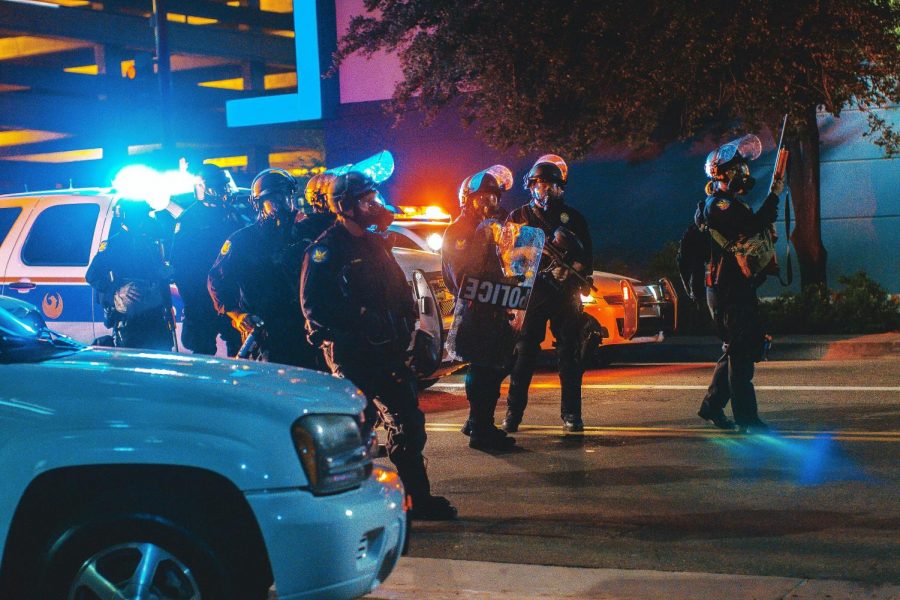The Shifting Nature of the Police
Why the militarization of the police is a threat to their responsibilities.
December 7, 2021
Mom’s 4 Housing is an Oakland-based organization that advocates for the human right to housing in the face of growing homelessness due to gentrification. It was founded by Misty Cross, Dominique Walker, and Carroll Fife: three mothers who decided to occupy a house that had been left vacant for two years by the real estate company Wedgewood. The house had holes in the roof and tree roots digging into the foundation, but could still provide vital shelter. After occupying the house for three weeks, the mothers received an eviction notice from Wedgewood on behalf of Catamount Properties. The mothers took the eviction notice to court, arguing against the eviction from the 1948 United Nations standpoint of housing as a human right. The judge ruled in favor of Catamount Properties, upholding the notice. The mothers refused to leave.
In the early morning of January 14th, 2020, the house occupied by Moms 4 Housing faced dozens of deputies from the Alameda Sheriff’s department armed with riot gear and AR-15 rifles. A robot was sent to assess the house for potential threats before officers arrested Misty Cross, the only occupant present. Mom’s 4 Housing and their supporting community members did not make any threats that would remotely justify such a militarized force. The response the mothers faced wasn’t about them, rather, it was and is about the shifting nature of the police.
This shifting nature is due to the intentional militarization of police in the U.S. Members of law enforcement are known for their responsibilities to enforce the law, maintain public order and safety, and investigate criminal activities. Policing systems have long been embedded in American society. The founding of the first police department in the U.S. occurred in 1844 in New York City. Policing then expanded quickly until it was the norm everywhere.
However, for a long time, there was a common understanding of the difference between the police and military. The police’s responsibility was to maintain order amongst civilians while the military’s responsibility was to protect civilians from outside threats. Naturally, their difference in responsibilities leads to a difference in needed resources and tactics to combat threats. These divided needs were steadily maintained until two turning points, the first and lesser being the 1033 program. This program was created and passed by Congress during the 1990s as an effort to support the War on Drugs. It prompted the informal giving of surplus military equipment from the Pentagon to police departments across the country. However, the event that truly sparked the shift in the police’s nature was 9/11.
A post-9/11 Department of Homeland Security enabled anti-terror grants that allowed police departments to purchase armored vehicles, armored personal carriers, and ballistic gear. These grants were given without consideration of if the departments were located near locations with reasonable concern for acts of terrorism. The grants’ original intention was to store military equipment for emergency use, but they quickly became a daily part of the job.
When police are trained, dressed, and armed in the same manner as the military, officers exhibit more militant mentalities. This doesn’t bode well for their domestic responsibilities of enforcing public safety amongst civilians.
Policing in the United States has an unquestionable legacy of brutality that was prevalent pre-9/11. However, the tactics used post-9/11 have increased the severity of this brutality. While more militant tactics do decrease crime rates, the poor behavior of the police decreases public opinion, prevents de-escalation, and leads to an increase in death. An example similar to Mom’s 4 Housing is the behavior police exhibited at Black Lives Matter protests. Across the country, people peacefully extending their right to freedom of speech to fight systemic racism faced rubber bullets, riot gear, and tear gas (a chemical weapon).
There is an attitude of trying to find crime without thought for if it is or isn’t actually one, leading to a stark lack of freedom for civilians who are supposed to be protected by the police. This militarization came from a desire to combat possible terrorism. However, when a part of the population is more fearful of what the police could do to them rather than relieved by how they can protect them, there is a desperate need for change.

